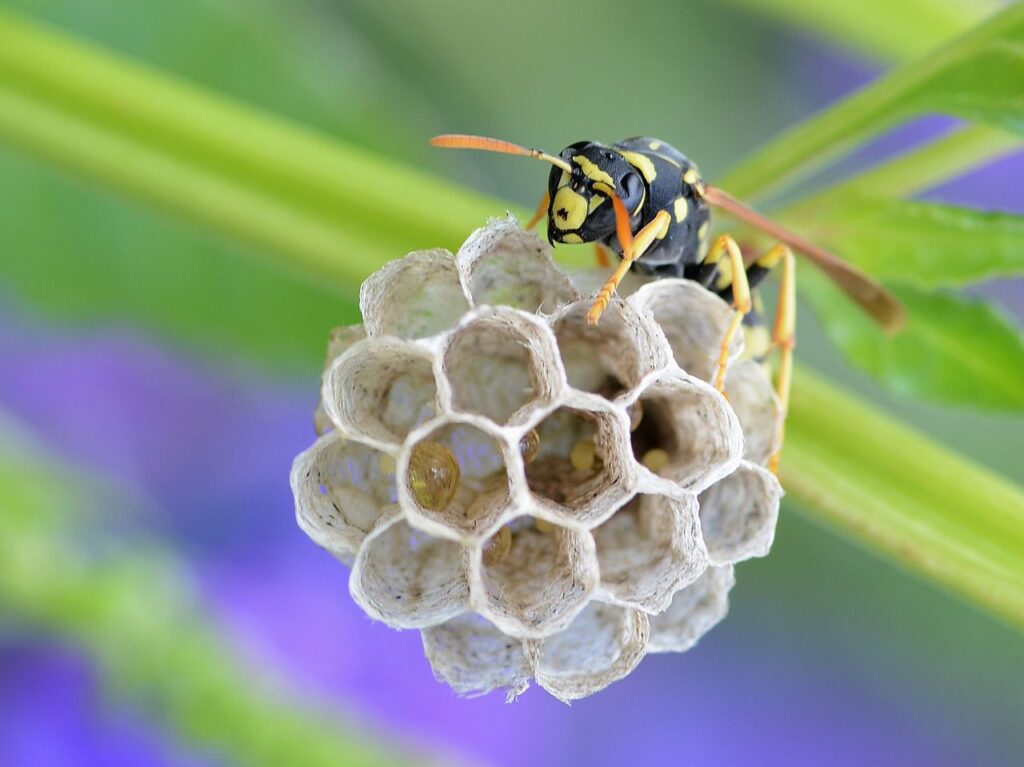
Appearance
The umbrella wasp (Family Polistinae), also known as the paper wasp or Polistes wasp, measures approximately 1 to 1.5 inches long. Its distinctive yellow and black coloration closely resembles that of a bee.
Overview of the Umbrella Wasp
The umbrella wasp is commonly found nesting under the eaves of houses and is often mistakenly referred to as the “paper wasp.” This nomenclature can be confusing since other wasp species, such as yellow jackets and hornets, also create larger paper nests. The term “umbrella wasp” is more fitting, as their nests resemble upside-down umbrellas.
Nest Identification and Structure
The umbrella wasp’s nest is a common sight, typically found on the eaves and upper corners of buildings. These nests measure 2 to 5 inches in diameter and dangle from a short pedicel, showcasing a honeycomb-like structure on the underside. The wasps construct their nests from weathered wood and plant fibers, which they chew into a pulp mixed with saliva. These nests rarely house more than 100-200 individuals, making them smaller than those of yellow jackets or hornets. The activity of these wasps is heavily influenced by temperature, making dusk or dawn the ideal times for treatment and removal of the nest when the wasps are less active.
Life Cycle of the Umbrella Wasp
The life history of the umbrella wasp shares similarities with that of yellow jackets and hornets, with the main distinction being its smaller colony size and unique nest structure. In fall, the queen mates with males, who subsequently die, while the queen finds a sheltered location, such as cracks or under loose bark, to hibernate.
When spring arrives, the queen emerges and chooses a location for a new nest, laying eggs and collecting food for the larvae. Once the first brood matures into adult workers, the queen focuses solely on egg-laying while the workers manage food collection and nest expansion. The nests are typically located under eaves or similar sheltered areas. Throughout the summer, these adult wasps feed on sugar-rich liquids and insects, ensuring the continued growth of their colony. In early to mid-August, the nest produces new males and potential queens, who mate nearby.
As winter approaches, males perish while females hibernate, abandoning their nests, which are not reused in subsequent seasons. Adult umbrella wasps consume various food sources, including fruit juices and insects, throughout their lifecycle.
Conclusion
Understanding the umbrella wasp’s characteristics, nesting behavior, and life cycle is essential for effective management and control. By employing integrated pest management (IPM) strategies, homeowners can minimize the risk of wasp stings while maintaining a harmonious environment.
By understanding these creatures, we can better appreciate their role in our ecosystems while effectively managing their populations around our homes.
For further reading on umbrella wasps and other social wasps like yellowjackets and hornets, visit the University of Maryland Extension’s guide on social wasps. It provides in-depth information on wasp behavior, identification, and control methods.
Protect Your Home Today – Contact Our Umbrella Wasp Control Experts!
If you’re facing issues with umbrella wasps or want to ensure your property is safe from these pests, don’t hesitate to contact Traffic Pest Solutions today! Our experienced team can provide effective control solutions tailored to your needs. Get in touch now for a free consultation!
